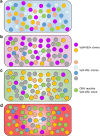Peripheral clonal selection shapes the human γδ T-cell repertoire
- PMID: 28782752
- PMCID: PMC5596248
- DOI: 10.1038/cmi.2017.51
Peripheral clonal selection shapes the human γδ T-cell repertoire
Conflict of interest statement
The authors declare no conflict of interest.
Figures

Comment on
-
Human γδ T cells are quickly reconstituted after stem-cell transplantation and show adaptive clonal expansion in response to viral infection.Nat Immunol. 2017 Apr;18(4):393-401. doi: 10.1038/ni.3686. Epub 2017 Feb 20. Nat Immunol. 2017. PMID: 28218745
References
-
- De Rosa SC, Andrus JP, Perfetto SP, Mantovani JJ, Herzenberg LA, Herzenberg LA et al. Ontogeny of gamma delta T cells in humans. J Immunol 2004; 172: 1637–1645. - PubMed
-
- Carding SR, Egan PJ. γδ T Cells: functional plasticity and heterogeneity. Nat Rev Immunol 2002; 2: 336–345. - PubMed
-
- Pardoll DM, Fowlkes BJ, Bluestone JA, Kruisbeek A, Maloy WL, Coligan JE et al. Differential expression of two distinct T-cell receptors during thymocyte development. Nature 1987; 326: 79–81. - PubMed
Publication types
MeSH terms
Substances
LinkOut - more resources
Full Text Sources
Other Literature Sources

